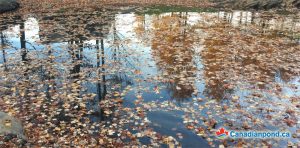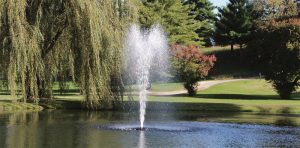Principles of Pond Health Management
Why is pond health management so important?
Ponds are living entities, which evolve and age. If left alone lakes gradually fill in and become swamps and ultimately meadows. This process is natural. It can take thousands of years or just a few depending largely on the geomorphology of the lake and activities around the lake. People may think that they want a “natural” pond, but what they really want is to maintain the pond in a relatively young condition rather than letting it age and transform into a swamp. This is no different than what people try to achieve around their homes. Considerable time and money are spent maintaining gardens in a particular age or state rather than letting them evolve naturally to weeds and shrubs. Lakes also require knowledge and maintenance to assure their health and continued beauty.
 Healthy ponds contain balanced communities of microorganisms, invertebrates, fish and plants. If the populations of the communities become unbalanced the health and longevity of the lake can be detrimentally affected. For instance, algae and other aquatic plants produce cell mass from carbon dioxide by the process of photosynthesis. The death of these plants results in increased deposits of carbon or sludge within the lake. Excessive plant growth usually results in rapid accumulation of sludge, filling in, aging of the lake and even in production of noxious odours and bad flavour in the fish.
Healthy ponds contain balanced communities of microorganisms, invertebrates, fish and plants. If the populations of the communities become unbalanced the health and longevity of the lake can be detrimentally affected. For instance, algae and other aquatic plants produce cell mass from carbon dioxide by the process of photosynthesis. The death of these plants results in increased deposits of carbon or sludge within the lake. Excessive plant growth usually results in rapid accumulation of sludge, filling in, aging of the lake and even in production of noxious odours and bad flavour in the fish.
The well-being of the biological communities is directly affected by the physico-chemical conditions within the lake. The oxygen and phosphorous levels, the depth and shape of the lake and the bottom substrate among other factors, interact with the biological communities to influence overall lake health. This is what aquatic ecology is all about.
What you can do for good water management
There is no miracle solution to a good pond health management, but there are many tools, which can be used by ecological engineers to restore and maintain lakes. Among these are aeration, bioaugmentation (the inoculation of water purifying bacteria to help maintain a healthy habitat), biofilters, chemicals which bind phosphorous or reduce algae or oxidize sludge or pigments that colour water, plant harvesting and dredging, etc. Pond health management requires monitoring of the physico-chemical and biological processes to decide which tools are appropriate and when they should be used.
 Pond aeration is the best method to control water quality and algae, in almost every situation. It is very important not to overlook aeration in small basins and in ponds which have a large organic load and that are typically mucky at the bottom. We strongly favor air diffusion at the bottom of the pond as the best form of aeration. Fountains and cascades are aesthetically pleasing and offer some surface aeration but they do not provide oxygenation of the sediments, precisely where the greatest demand for oxygen is. We suggest you fill in our on-line consultation form to get a proposal.
Pond aeration is the best method to control water quality and algae, in almost every situation. It is very important not to overlook aeration in small basins and in ponds which have a large organic load and that are typically mucky at the bottom. We strongly favor air diffusion at the bottom of the pond as the best form of aeration. Fountains and cascades are aesthetically pleasing and offer some surface aeration but they do not provide oxygenation of the sediments, precisely where the greatest demand for oxygen is. We suggest you fill in our on-line consultation form to get a proposal.
There are five principal steps to successful pond health care maintenance or restoration program:
- Definition of the treatment goals, what exactly is desired and what is possible — e.g., clearer water, control of algae and/or rooted aquatic plants, a sport fishery, odour control, a refuge for water fowl, boating, water skiing, swimming, supply of irrigation water. Some of these goals may conflict with others. It is important for users of the pond to clearly understand what is possible and realistic and what is not.
- Definition of physico-chemical and biological realities — Parameters such as shape and depth of the pond, water and chemical inputs and outputs, physico-chemical composition of the water and biological populations within the pond, are critical factors to be integrated in a management plan. The health of the pond cannot be assured without considering the surrounding drainage basin with respect to runoff, fertilizing practices, etc. Considerable data may already exist. If not, this data will have to be collected so that an intelligent management program can be planned to achieve the targeted goals.
- Development of the management program for the lake — This is based upon integration of the treatment goals (Step 1), knowledge of the lake (Step 2) and legal realities.
- Implementation of the management program — This includes a treatment plan as well as regular health monitoring. A sound pond health care maintenance program must be able to be adjusted according to the seasons, age or accidents. This approach is no different than what we do when we go to a doctor or a dentist. Examinations are required to optimize treatments.
- Feedback and interaction between the lake health care team and users association — In the case of management of lakes it is essential to maintain regular communication with the users associations for feedback on the program as well as possible changes in the treatment goals (Step 1).
©1999
Karl F. Ehrlich, Ph.D & Marie-Claude Cantin Ph.D